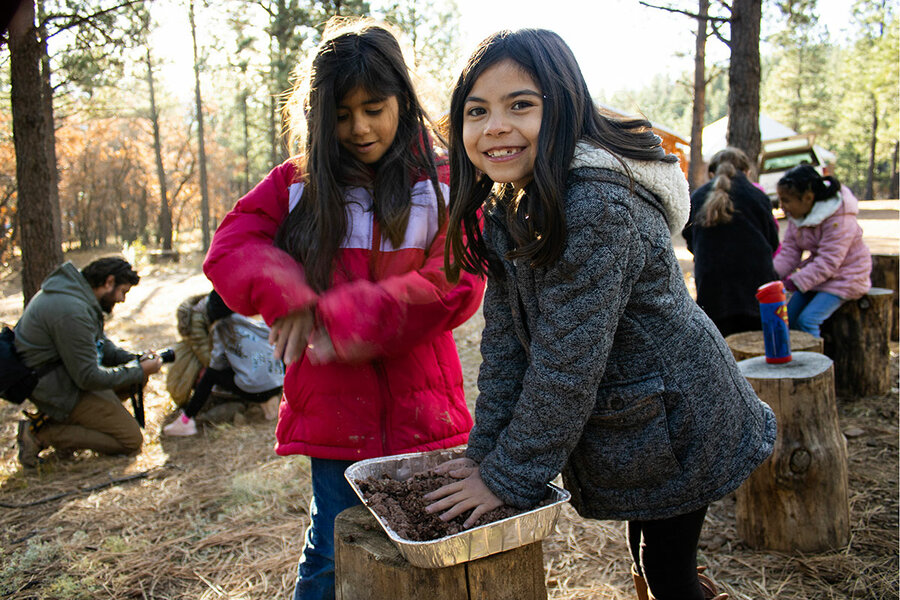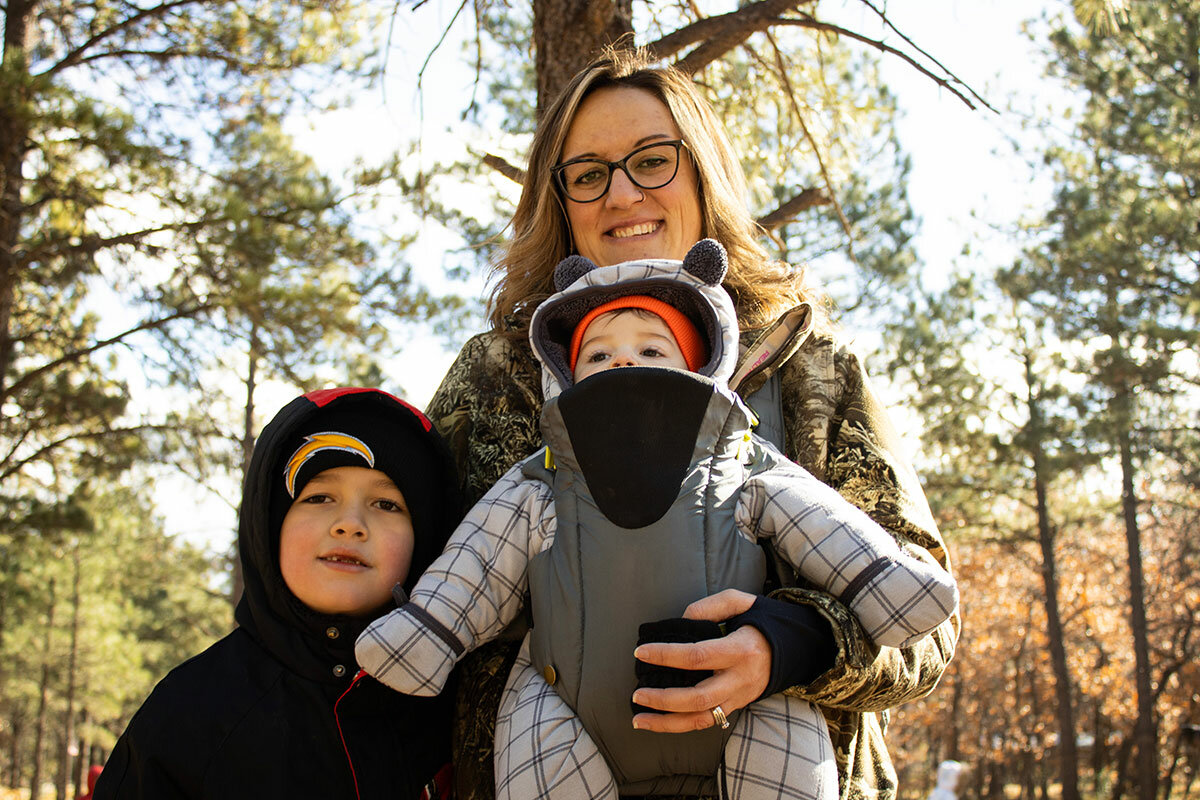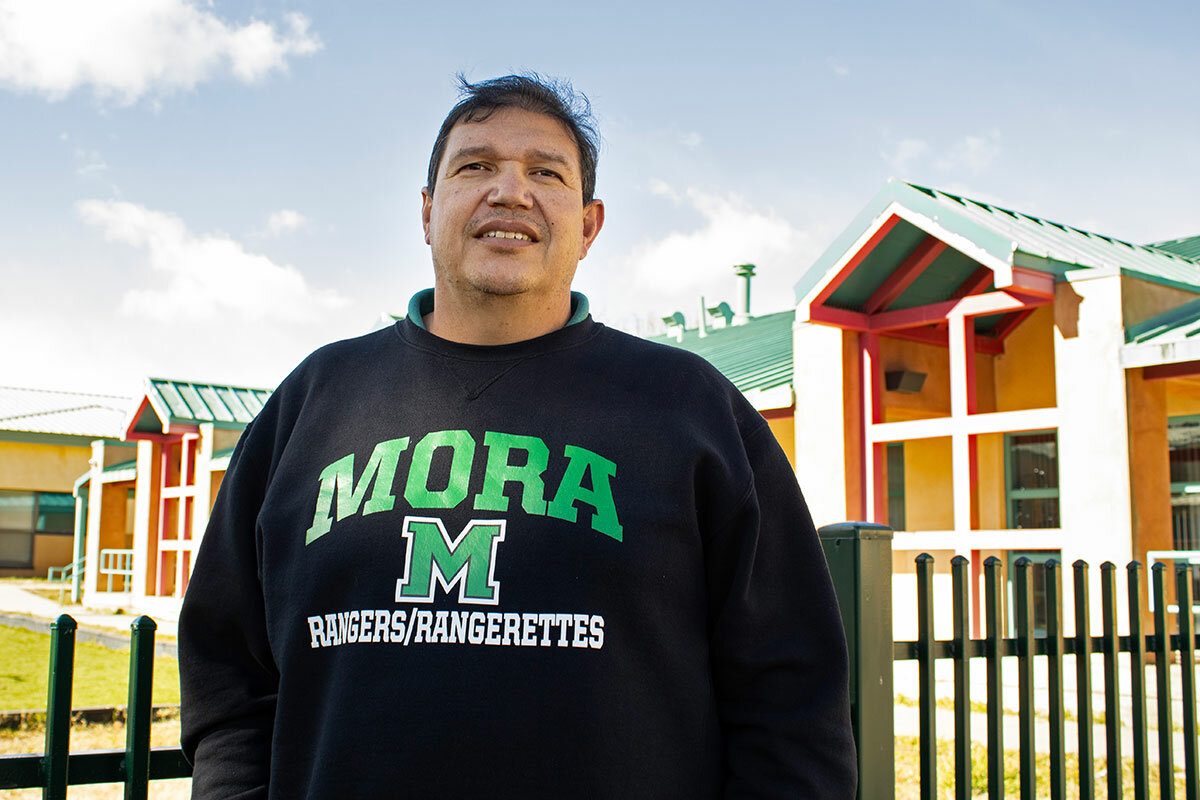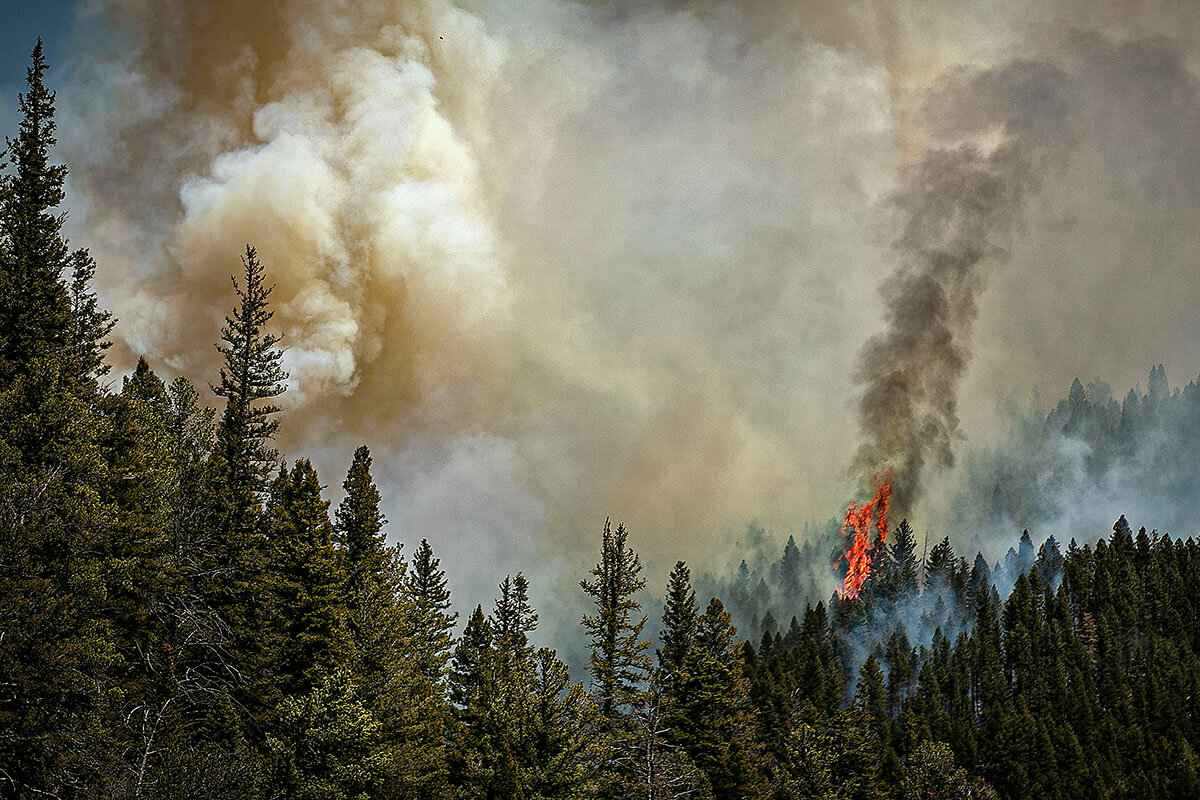First fire, then floods. How a school district helps students recover.
Loading...
| Mora County, N.M.
Small hands round clumps of wet clay and compost, forming sticky spheres. Sara Villa watches her second grader, Aaron, focus on the task, his jacket hood raised against the November chill. He’s one of several dozen students on a school excursion at a New Mexico ranch.
The Villas evacuated their nearby Holman home in the spring due to wildfire, then again in the summer due to floods. Because of water damage, the family went into debt purchasing a new mobile home, says Ms. Villa. Other scars are harder to see.
Aaron gets “scared now when it rains,” she says. “I just try to explain to him that he’s OK.”
Why We Wrote This
A story focused onAfter fire and floods, life moves on – so does school. One resilient district in rural New Mexico is linking lessons of land recovery to student recovery.
Aaron, shy, offers a snaggletooth smile. The ball in his mud-smeared palms is stuffed with seeds of native grasses. Students can plant these “seed bombs” where they please, such as at home or here at Collins Lake Ranch, where about half of its 300 acres burned last spring in the state’s largest recorded wildfire.
The activity is part of a school district experiment linking environmental recovery to that of students, whose families lost ranchland, income, freezers full of food, and safe drinking water. This school year, the rural Mora Independent School District (MISD) has tried several ways of harnessing lessons about such disasters to “promote the healing,” says Superintendent Marvin MacAuley.
Beyond an “expeditionary learning” model that brings students outdoors, the district hired a second social worker to deal with an upswell of behavioral issues. MISD has also doubled down on logistical preparedness, which includes ongoing food distribution to local families and the drafting of school flood-response plans.
Laura Schifter, a senior fellow at the Aspen Institute’s initiative This Is Planet Ed, appreciates the district’s efforts. “Schools really need to be adapting and building resilience to climate impacts, and what this district is doing in thinking about it holistically can really be used as an exemplar for other districts to consider,” she says.
Not unlike the weather radio that Mr. MacAuley keeps on his desk, antenna raised at the ready, district staffers have had to broaden their attention to student needs that include not only academics but also resilience.
“I want them to recover. I want them to succeed,” says the superintendent. “I want them to become valuable community members, and cherish their cultures and their traditions, and be able to revive our area.”
“Adaptability is a key”
Family trees in Mora County intertwine with Indigenous, Spanish, and Mexican histories; some residents trace back ties to the land through nine generations. The district of around 400 students – most are Hispanic, and nearly all qualify for free or reduced-price lunches – sits among expanses of cattle ranchland threaded by a river. Forests ring a valley where mission churches still stand.
But compliment Mora’s beauty and you may get a sigh. It used to be more beautiful, locals say, before the fire.
In April, prescribed burning in Santa Fe National Forest botched by the U.S. Forest Service grew into the largest wildfire in recorded New Mexico history. The blaze of over 340,000 acres was fueled by adverse conditions that the government says it underestimated. April set a record dry average for the state in terms of precipitation: five-hundredths of an inch that month.
Climate change “likely played a major role” in the overall dryness of the area, which was compounded by a La Niña climate pattern that makes for drier- and windier-than-average springs, says Andrew Church, meteorologist at the National Weather Service in Albuquerque.
As the fire blazed, Mr. MacAuley, a former wildland firefighter for the U.S. Forest Service, made the call to send students and staff home early. Evacuations followed. After a “chaotic” two weeks, he says displaced teachers resumed lessons through a semblance of virtual learning. Though the district had begun using 1-to-1 computing during the pandemic, not all children evacuated with devices, let alone landed where they had access to Wi-Fi.
The district’s Head Start program, meanwhile, began a distribution center on-site, serving hundreds of people a day with food, water, livestock feed, and more. The full-fledged operation lasted some 45 days, but due to ongoing need nine months on, the early childhood center still organizes a monthly food distribution and hands out firewood commonly used to heat local homes.
Summer flooding from thunderstorms was made worse by the wildfire. At the start of the fall semester, flooding cued two early dismissals and the sheltering of students late at school until the roads cleared.
“I teach them that it’s important to be adaptable and to be willing to change with what’s going on,” says middle school English teacher Tina Burton-Crunk. “Adaptability is a key thing to being able to survive anything.”
Student helpers
Researchers are beginning to understand the impact of climate change on young people, including through self-reporting of “climate anxiety.” In April 2021, a year before the New Mexico blaze, the National Association of School Psychologists adopted a resolution recognizing the importance of mitigating climate-related harms (like air pollution, extreme heat, and wildfire) to the learning and mental health of students.
MISD is now equipped with cots, food, and water in case of future needs to shelter students. And the district used American Rescue Plan Act education funding to hire the second social worker based on a spike in social-emotional needs, with a third contracted on an as-needed basis.
Longtime district social worker Deyhle Adkins says some students “internalized [the natural disasters], and they started acting out, and you’d see these erratic behaviors,” including bullying. But others took it “really well, and they wanted to help out,” she adds.
Senior Casey Benjamin is among those who helped, as a junior firefighter. Sixth grader Ana Crunk, daughter of the teacher, volunteered at an evacuation center in Peñasco.
Though it was “scary” to flee home, helping out “helped me feel better,” says Ana, whose own family was evacuated for two weeks.
Ana is also a fan of the learning expeditions. “I love it because I’m outdoors, and I don’t have to be in the classroom,” she says.
Next: the Envirothon
Mora’s expeditionary learning, first mentioned in a report by Searchlight New Mexico, is partially meant to address social-emotional needs. Sometimes called experiential or project-based learning, the hands-on learning approach was developed by educators in the 1990s.
Since the fall semester, several expeditionary learning days, including the seed bomb outing, have taken place at Collins Lake Ranch, a nonprofit serving people with disabilities. In other lessons there, students learned to fly drones for aerial data collection and tested post-fire water quality, in partnership with the New Mexico Forest and Watershed Restoration Institute at New Mexico Highlands University. They also helped blaze a hiking trail at the Rio Mora National Wildlife Refuge and Conservation Area. The district is pausing these Friday excursions during the winter months – taking kids skiing instead, in part to show them that “we can still enjoy our mountains and some things have not changed,” Mr. MacAuley adds in an email.
Some older MISD students have been less impressed with or interested in the Friday outings. While some sessions have been “informative,” says freshman Michaela Aragon, “sometimes you’re really just kind of bored with them.”
But her mother, board of education chair Monica Aragon, sees an upside.
Since the start of the pandemic, “they don’t just have to learn how to focus; they have to learn how to socialize,” she says. “That’s what these fun Fridays are trying to encourage.”
Other parents stress the need for more academic recovery.
“We know that somewhere along the line, years from now, those trees – life – continues,” says Judy Martinez, who has five children in the district, kindergarten through seventh grade. “But academically is where the suffering took place.”
She recalls the challenge of managing her students’ pandemic remote learning, and then how they lost out on remote learning for a few weeks last spring as the family hurriedly evacuated without its laptops. Students deserve patience from their teachers for being behind through no fault of their own, she adds.
Students attest to the difficulties as well. “Every year of my high school career, we’ve been out a portion of the year or the whole year,” says senior Casey. Disruptions to learning have made students “pretty unattentive,” he adds.
Mr. MacAuley recognizes the uphill climb that lies ahead. He says Mora students are generally a year behind where they should be academically – some two years, due to remote learning challenges.
There’s another plan he hopes will help the high schoolers in particular. The district has launched its first team to enter the New Mexico Envirothon, a problem-solving competition that tests student knowledge of natural resources. It’s another idea from what Mr. MacAuley calls “my crazy mind.”
Above his desk with the weather radio hangs the skull of a mule deer, shot by one of his three daughters. Asked how many kids he has, however, he doesn’t say three.
“I say I have 425,” he says.
That includes second grader Aaron Villa. According to his mom, he cast a seed bomb into a burn scar behind his former home.










